Alpine Climbing in Alaska’s Revelation Mountains
New routing in Alaska’s Revelation Mountains by Kris Irwin
Captivated by the immense beauty and virtually untapped lines of ice, snow and rock, the first thing I remember hearing from our pilot is …”Double check that your seatbelts are on”. He then proceeded, without hesitation, to drop us into The Revelations of Alaska. As we begin descending, we see this massive valley opening up below us and we are all impressed by what we are looking at. Three to five thousand foot granite walls, tumbling icefalls, hanging glaciers, long and steep snow couloirs, and hundreds of large nunataks that dot the glacier below. Paul, our pilot, makes three turns in his Otter to make up the distance between us and the ground, and scopes out a landing on the upper glacier. There is a French team of four climbers that are not expecting us, and run out from behind one of those large nunataks in time to see us land next to their camp and what will be our home for the next three weeks.
On the flight in with Paul Roderick at the controls, video by K. Irwin
The Revelations are remote and seldom-visited. As the crow flies, this area lies 225 kilometres south-west of Talkeetna, 70 kilometres south west of the Kichatnas, and a long way from Denali National Park. Talkeetna Air Taxis’ motto is “hike for a week, or fly for an hour.”, but this trip on foot would likely take three times that and you would need to cross some serious mountainous terrain to get there. The highest peak in the range is Mt. Hesperus at just less than 10,000 feet. Most peaks lie between seven thousand and that. Although not very high, the vertical relief between valley bottom and these summits can be up to 5000 feet, offering numerous snow, ice, and mixed lines.
Though the Revelations have seen little exploration, it does have some notable history. Dave Roberts and fellow Harvard Mountaineering Club members George and Rick Millikan, Matt Hale, and Ned Fletcher first explored this area on a 52-day expedition in 1967. Roberts and co achieved nine first ascents and named the range and many of its notable peaks. They endured atrocious weather throughout their visit and were turned back on several outings from bouts of wind and freezing rain. Since that first recorded visit, the range has seen very few visitors, and there were only a half dozen parties to make the long, committing journey until 2008. Between 2008 and 2013, an ambitious Anchorage mountain man, Clint Helander, along with various partners, made annual trips to the range and racked up numerous first ascents. His article in the 2013 American Alpine Journal unselfishly highlighted many of the unclimbed peaks’ and unclimbed mixed routes and commented on their potential weaknesses. Ian Welsted, Darren Vonk, Mark Taylor, and I were recipients of The John Lauchlan Memorial Award in 2014. After reading Clint’s article, we were intrigued by The Revelations, its solitude, and its unclimbed gems. Unfortunately Mark suffered a back injury while ice climbing in the Ghost Wilderness Area, and was forced to bow out from the trip one week before our departure. Preparations were in place so Ian, Darren, and I decided to go as a team of three.
John Lauchlan was a talented and prolific ice and mixed climber in the Canadian Rockies and abroad during the late 70s and early 80s. John made many notable ascents and pioneered new routes nationally and internationally. An endowment fund was set up by The Alpine Club of Canada in his honour after an unfortunate climbing accident took his life in 1982. I never met John (I was 3yrs old when he passed away) but I learned that he inspired those around him and gave every climber a fearless example of what they can become. We were honoured and privileged to be in The Revelations, representing Canadian alpinism and the spirit of John.
Our home for the next 23 days was set up at the head of The Revelation glacier, at approximately 5000 feet. Camp consisted of two 4 season tents within fortified snow walls, and an impressive two room igloo that was built by the French team. We renovated the igloo to include cooking platforms for our camp stoves, shelves, seating for 3, a spice rack, food storage space, and a liquor cabinet. Nearly every food item (except for the bourbon) froze within the first week, as temperatures plummeted to -25c for a few days. It’s a good thing we brought lots of stove gas, as food needed to be boil-thawed before cooking.
On our second day in the range we geared up for a cragging day, on what I thought was a low elevation mountain called Hydra Peak. Two discontinuous parallel mixed lines had formed on the east face. We went for the more appealing right hand line. After climbing 12 pitches or so of new mixed terrain of up to M5, WI4+, and then post holing for a couple hundred meters, we arrived at the top of the massive 2000ft buttress. We could now see a ridge before us that led to a much loftier peak. After a couple hours of ridge walking, and negotiating an icy traverse around a large gendarme, we finally reached the glaciated summit plateau. Not wanting to retrace our route, we decided on the most direct line down the north east ice fall. Thirteen long rappels off glacial ice, one large bergschrund crossing, and some night time navigating brought us back to our camp 17.5 hours after we left – the longest cragging day I’ve ever had! Unknowingly, we realized that we had just climbed Angel Peak, by a new route that we called ‘The John Lauchlan Memorial Award Route’, 1200m AI4+ M5, April 3rd 2014 – Irwin/Welsted/Vonk. The ridge to the summit had been climbed before, so 600m of this route was new terrain.

Darren Vonk climbing steep ice on the first ascent of ‘The John Lauchlan Memorial Award Route’, photo by K.Irwin
Over the next week we attempted and retreated off of two mixed lines on the neighbouring Four Horsemen and Cherub peak. Both lines were of high quality but spindrift avalanches and snow filled chimneys turned us around.
Kris Irwin seconding a stellar pitch on Cherub Peak
In planning for our next objective, we recalled spotting a snaking thin ice line on the unclimbed Dyke Peak. We caught another glimpse of this line after a ski recon in deteriorating conditions. The bottom half of the route, with its thinely iced up corners, looked so good we had to try it. The route did not disappoint, and we found pitch after pitch of amazing thin ice and single swing steep neve. I led two thin pitches of WI5 ice that opened up passage to the moderate upper mountain. Darren took over and we simul-climbed a couple hundred meters of super fun thin ice and firm steep neve. With Ian in the lead we traversed down and right 80 meters and entered the dyke feature after which the mountain is named. “Sometimes you have to go down to go up” Ian said as we arrived at the belay. We climbed the dyke past an impressive chalkstone and onto the summit for our second new route and the first ascent of the mountain via ‘Powered by Beans’, 1000m AI5 M5, April 11 2014 – Welsted-Irwin-Vonk. 17hrs camp to camp.
Ian Welsted leading a sniced up corner on the first ascent of ‘Powered by Beans’
With two routes down and warmed up to the climbing in the Revelations, we were ready for our main objective, the unclimbed central gully on Pyramid Peak. This is the line we pitched in our John Lauchlan Award application, the line we came here to climb. Pyramind Peak had remained unclimbed until the 2014 climbing season, when the French team established a new route up the right hand flank of the west face called the ‘Odyssey’ (1100m, 6b A1 M7), just days before our arrival. On our first attempt we climbed 10 pitches, with vertical sections of high quality mixed climbing and some not-so-high-quality snow climbing. Ian made a good point that “if you dig far enough down through the snow, you will eventually find cracks”. He was right, but the time and effort needed to find these cracks was eating up the day (and our energy reserves), and we had not yet reached a small slope where we had planned on digging into for the night. Now the snow began to fall, ever so slightly, but spindrift avalanches starting pouring down over us with alarming size and frequency. We bailed and agreed to return when we had a solid weather forecast.
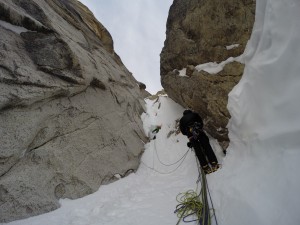
Ian Welsted digging through steep snow and looking for cracks on our first attempt of Pyramid, photo by K.Irwin
After a day of rest from our foray on Pyramid, and a good weather forecast ahead of us, we looked for something close to camp. Darren had spotted a shorter looking line on the east face of Hydra Peak. With a long snow gully approach, 5-6 pitches of technical mixed climbing, and a beauty ridge climb to the summit, this turned out to be an excellent outing after our disappointing turn around on Pyramid. After a fun 10 hour day we decided to call this the ‘Casual Route’, 600m AI4 M6, April 17th 2014, Vonk/Welsted/Irwin
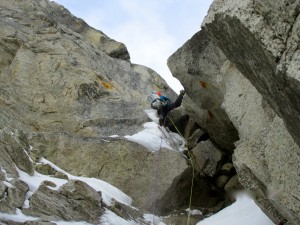
me leading an overhang on the first ascent of the ‘Casual Route’ on Hydra Peak, photo by Darren Vonk
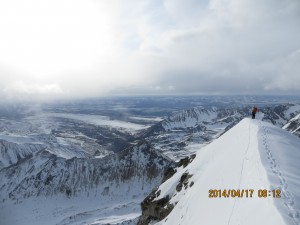
Darren Vonk looking west on the summit ridge of Hydra Peak on the first ascent of the Casual Route, photo by K.Irwin
Ian Welsted enjoying high quality mixed climbing on the first ascent of the Casual Route, vid by Kris Irwin
After 3 new routes completed we channelled our remaining energy for another attempt at Pyramid Peak. Our trusty weather man and my good friend Rob Smith sent us a weather forecas via sat phone, “high pressure next few days, time to go big!” We packed light and planned for a bivy at the midway snow ledge. On day one we reached our high point fairly quickly, utilizing the rappel anchors we left the week before. New pitches of increasingly steep snow mushrooms and blank granite slowed us down, but we reached the snow ledge by 6pm. We fixed the next pitch, and spent an hour digging out a suitable platform for our small tent. Darren and Ian shared the tent while I chose to spend the night in belay pants curled up on my empty backpack. At dawn we started to pack up and continued climbing for two long and tedious pitches. With more overhanging snow and increasingly unprotectable climbing, the attempt was becoming futile. After closer inspection of the pitches ahead, we could see the climbing was very steep and committing. The wide cracks, that we thought were choked with ice were unfortunately plugged with snow. We were hoping to find a long WI6 pillar that Clint had photographed the year before, but it had not formed. We wanted to continue, but the decision to descend was unanimous… and a smart one. Just a half hour after skiing away from the base of the route, a large chunk of cornice collapsed from the summit ridge and debris charged down entire length of the route. I stood there gasping, knowing that if we had still been up there, we would have surely been swept off the mountain.
Our bivy spot on our second attempt of Pyramid Peak west face, vid by Kris Irwin
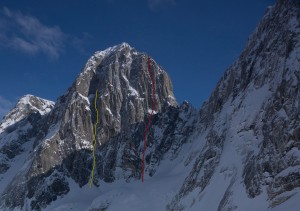
West face of Pyramid Peak showing the French ascent in red and our attempt in yellow, pic by Ian Welsted
This beautiful and remote valley is worth the visit. Solitude and true adventure is almost guaranteed. There are more possibilities for moderate and cutting-edge climbs, lengthy ridge traverses, enchainments, and steep couloir skiing. The Revelations are the last of a largely unexplored region of Alaska, and one of the few true wilderness areas of North America. I was lucky enough to have such a remote experience, and my journey there will never be forgotten.
BIG THANKS
This trip would not have been possible without the financial support of the John Lauchlan award funds. A big THANK YOU goes to the committee, the sponsors (MEC, Arcteryx, Yamnuska, Calgary Foundation, Lake O’Hara Lodge, Explore Magazine, Rab, Integral Designs, Tony and Gillean Daffern, Don Milliken, Bill Hanlon) my partners Ian and Darren for their energy and enthusiasm, Mark Taylor for helping with the planning, my wife Ellen for her love and support, my trainer Greg Silva for the lungs and the legs, Onward Up (Petzl, Patagonia), and Rob Smith for the weather updates.

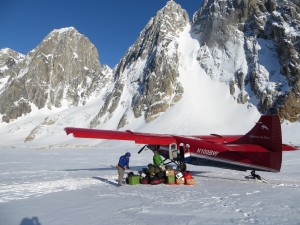

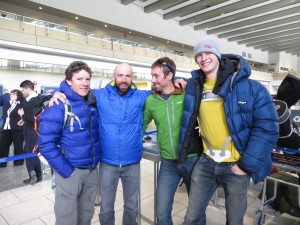
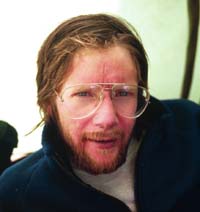
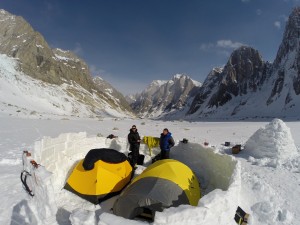
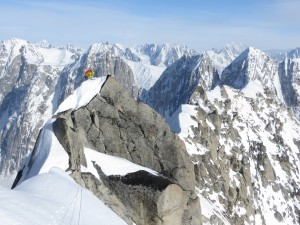

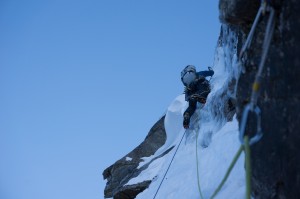
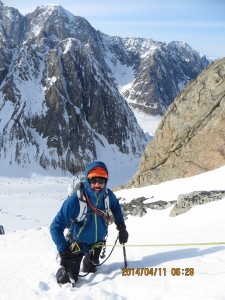


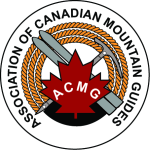


No comments yet.